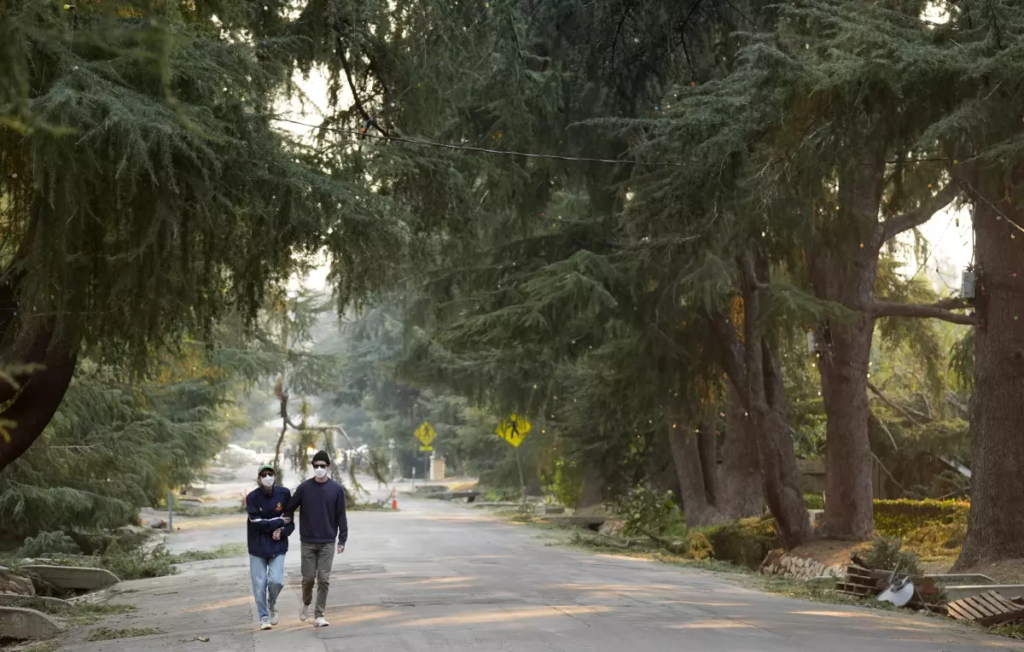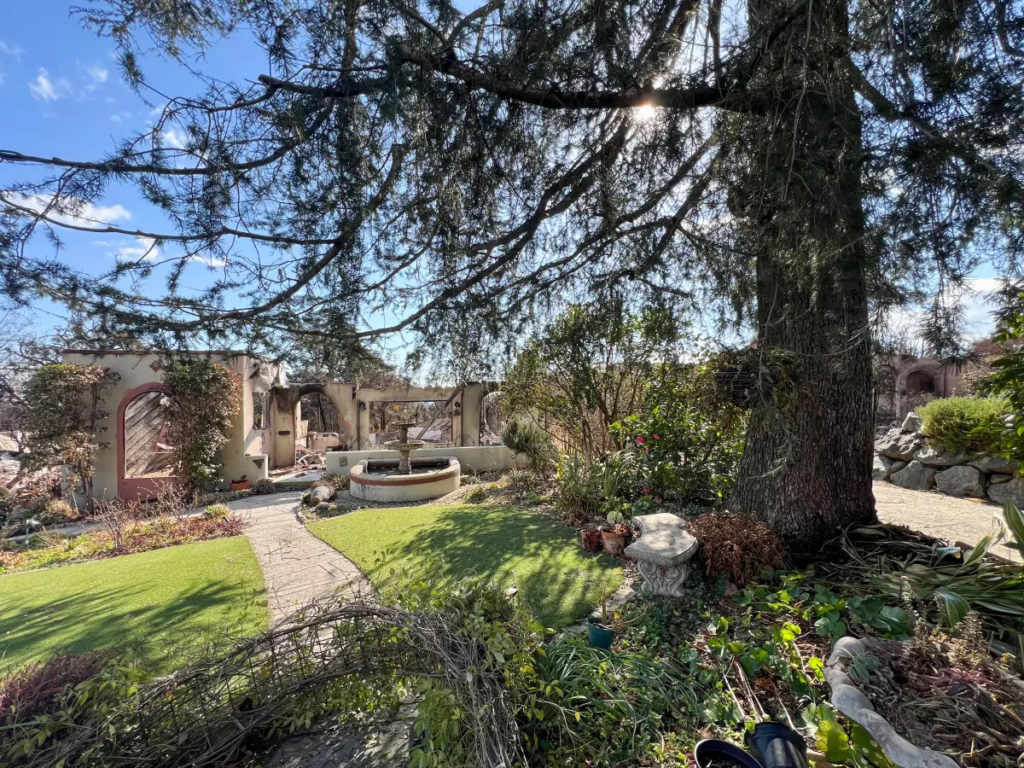The Purple Fernleaf acacia was radically limbed up while I was in Oregon, due to its canopy encroaching on neighboring roofs and fences. It was one of the more shocking sights in the garden upon our return in October. Marty supervised the job while I was in Oregon and told me yesterday he was inclined to take out the entire tree! He’s always been very anti plants near structures, and I’ve slowly, grudgingly come around to his POV, especially so after the January urban wildfires.
Another benefit of the acacia pruning has been providing room for the unnamed trevesia to grow. I think the initial pruning may have allowed in too much sunlight, causing the leaves to singe, but hopefully now it will settle into the new dappled light. The trevesia planted in 2020 tolerated surprisingly dry conditions these past years, but I’m wondering now if the garden’s success was due to two very rainy winters.

The next project we’re dreaming up is a misting system rigged on the pergola for the pots and tillandsias underneath.
And it turns out our acacia’s odd silhouette was ahead of the curve, because after the January wildfires seemingly everyone, homeowners and professionals alike, got busy cutting back trees. And aesthetics were not top of mind, just the goal of a 5-foot clearance of plant growth from structures and utility wires. Our parkway jacarandas were pruned by the utility companies just a couple months ago too, but after the fires the trees trimmers came back with an even more radical trimming agenda in mind. Buried utility wires would turn our neighborhoods into urban parks, but until then…it’s almost looking like Stumptown South. The parkway trees are now short and squat, unlike my lanky acacia.

There may be a fit of tree-trimming ongoing now, but in actuality many trees withstood the firestorm surprisingly well, and it was more the houses that provided the fuel for the conflagration. In an LA Times article on what trees survived the fire, oaks, deodar cedars, camphor trees (Camphora officinarum), and sycamores were some that merited mention. Cristhian Mace, natural areas biologist for LA Co. Parks & Rec, “was thrilled, however, by how well the oaks and sycamores fared around the Eaton Canyon Nature Center, which burned to the ground. ‘Every mature sycamore I saw [in the canyon] had some dark scarring on their bases, but that was it,’ she said. And almost all of the oaks came through just a little singed, ‘so both trees proved their heartiness.‘”
And “Sometimes it’s just the luck of the draw — or the direction of the wind, said Altadena native Rebecca Latta, a biologist and certified arborist. ‘When the fire’s hot enough, it doesn’t matter what you do, but I’m concerned that people are vilifying the trees,’ Latta said. ‘Houses are concentrated fuel sources, and what we saw here is that the trees got burned by the houses next to them burning, not vice versa.’”

(Jeanette Marantos / Los Angeles Times)
The articles may be paywalled, so one more quote: “Many other large conifers like pines survived the fires too. In fact, many of the biggest survivors appear to be evergreens such as conifers and native oak trees, said fire safety educator and landscape architect Doug Kent, who recently visited the burn areas in Altadena. ‘The oaks did an incredible job; they really lived up to their mythology as fire catchers,’ Kent said. ‘And the camphors, which are not native, did a great job too. They’re a popular evergreen tree with a big, open canopy, like an umbrella with reddish green leaves.’”
So with fire and water very much dominating our thoughts and conversations, we naturally turned to…the water hogs. In March of 2011 I wrote about a modular water storage system I admired, designed in Australia. The system was briefly available through Groupon (is that still around?!) and we bought six, capable of holding 51 gallons each. The units can slide horizontal under a deck or stand vertically, but we never found the perfect Goldilocks location and stored them in the attic. With the narrow strip behind the garage/office recently cleared out to paint the fence (my former potting area with shelves), Marty decided this might be the time and location to install the water hogs.
Weirdly, there’s not much info available on the system since the initial fanfare that attracted my attention, which would suggest that they are not in widespread use. And that may be due to the fact that after rigging them with the included plumbing hardware, the system leaked. Not the food-grade water hogs themselves, just the fittings. Marty bought new plumbing pipes and connectors locally, and now the system is watertight. It’s not connected to the roof gutters but used just as water storage for now. (And in fairness, that the original fittings leaked may also be due to being stored in a hot attic for 14 years.)
Bringing the eye down to ground level for some plant talk, the Echeveria agavoides moved to the back garden to fill in gaps are settling in, and now a few distinct kinds can be discerned. Echeveria ‘Frank Reineilt’ is the largest, with broad pointed leaves, an open habit, not as incurved as the species.
Found in eight locations in Mexico, it is an extremely variable species, so it’s no surprise I’ve brought home a few different kinds over the years.
If I’m correct that this is ‘Maria,’ it also has an open habit with short apple-green leaves. tipped in red. As the echeverias adjust to this sunnier site, their true coloring will develop and help with IDs.
I may have also spotted a very small, single rosette of ‘Lipstick’ (or ‘Ebony’), but the majority are the rapidly offsetting kind that may or may not be Echeveria agavoides ‘Prolifera.’
Two days after the Los Angeles fires started on January 7, I noticed an article published in a journal entitled “Hydroclimate volatility on a warming Earth” that describes a noticeable whiplash effect characterized by “frequent transitions between very dry and very wet conditions.” Los Angeles’ previous two wet winters followed by extended drought certainly fit the model. And now the term “whiplash” is everywhere. Very apropos of so much these days, right? A whiplash world. I’m trying to use my attention judiciously, no longer expecting to discover when the just causes triumph but instead following the outlines of the damage being done to bear witness. Let me know how you’re coping! Take care, stay well!















Your garden’s looking good, Denise. My Aeonium ‘Super Bangs’ don’t look nearly as robust as yours but hopefully mine will become more vigorous now that they’re in the ground and getting some rain.
My husband and I’ve had a preliminary discussion about the 5 foot parameter around the house, which would necessitate the removal of a lot of the foundation shrubs and change the entire look of my garden. That depresses the heck out of me. I’ve got a Bushman rain tank behind our garage, which holds 265 gallons (in addition to the 115 gallons I get from my smaller tanks). Unfortunately, it feeds off the smallest roof surface but it was the most tolerable placement. I should look at the prospect of a horizontal placement of a waterhog elsewhere (if I can even find one).
Kris, it is a painful discussion to have. It would mainly be in your front garden, right, because your back area has the buffer of your patio and paths. You’re already way ahead with the trees and regular arborist visits. And the trees that are irrigated, taken care of, like yours, are much less likely to ignite. There’s always a way forward!
Andrew thinks a lot like Marty. Take 5-ft away from my planting space though and that’s a HUGE loss. I actually love the look of your trimmed acacia, but that’s probably a bit like people saying how beautiful my photos of snow or ice are, when they aren’t the ones living it. As for coping, barely. I need to drop a few email newsletters as I sink lower and lower as I read them all.
I’m enjoying the winter updates from your LB garden. I had to remove my Acacia b. purpurea a couple years ago-it leaned on the fence after a wind event. I loved that tree but it was the right thing to do. I replaced it with a Hakea laurina . My experience with E. agavoides has been similar to yours relative to the variable nature. I seeked out ‘Ebony for years and finally found one and it still looks exactly like ‘Lipstick’ . I bought another one from a different grower maybe a year later and it also looks like ‘Lipstick’ . I keep moving it around to no avail . What a scary moment for Mitch and family ! Glad he got the hell out of there.
Interesting, I’ll admit I didn’t realize that homes were more fire fuel than the trees around. Your trimmed up Acacia looks great, and less mess is always something to be thrilled about. Trevesia, I yearn for one – I’m worried it’s just a touch too cold here. The water hogs blend so nicely to the side of the house, I like how tidy that looks. I get too many sloppy areas outside. The photo from your son is scary, we’ve had those red sky days here and it is awful. Love the last picture of your dusted off garden!
@Loree, same problem here with the 5-foot clearance, and there’s still a couple offenders. I’ve been trimming my reading too, mainly keeping to legal analyses.
@Kathy, so your acacia leaned on the fence! Yikes, I hope mine behaves. ‘Ebony’ is much less expensive now, just haven’t grabbed it locally yet.
@Tracy, the trimmed acacia reminds me of a eucalyptus. now! I like how the water hogs snug into the house too — wish I could find some more!